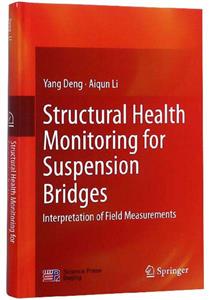-
>
闯进数学世界――探秘历史名题
-
>
中医基础理论
-
>
当代中国政府与政治(新编21世纪公共管理系列教材)
-
>
高校军事课教程
-
>
思想道德与法治(2021年版)
-
>
毛泽东思想和中国特色社会主义理论体系概论(2021年版)
-
>
中医内科学·全国中医药行业高等教育“十四五”规划教材
悬索桥的健康监测:实测数据分析解读(英文版)/邓扬 版权信息
- ISBN:9787030601261
- 条形码:9787030601261 ; 978-7-03-060126-1
- 装帧:一般轻型纸
- 册数:暂无
- 重量:暂无
- 所属分类:>>
悬索桥的健康监测:实测数据分析解读(英文版)/邓扬 内容简介
This book presents extensive information on structural health monitoring for suspension bridges. During the past two decades, there have been significant advances in the sensing technologies employed in long-span bridge health monitoring. However, interpretation of the massive monitoring data is still lagging behind. This book establishes a series of measurement interpretation frameworks that focus on bridge site environmental conditions, and global and local responses of suspension bridges. Using the proposed frameworks, it subsequently offers new insights into the structural behaviors of long-span suspension bridges. As a valuable resource for researchers, scientists and engineers in the field of bridge structural health monitoring, it provides essential information, methods, and practical algorithms that can facilitate in-service bridge performance assessments.
悬索桥的健康监测:实测数据分析解读(英文版)/邓扬 目录
1 Temperature Action Monitoring of Main Girder
1.1 Introduction
1.2 The NSB Description and Instrumentation
1.3 Spatial and Temporal Characteristics of Temperature Measurements
1.4 Effective Temperature Analysis
1.4.1 Correlation of Ambient Air Temperature and Effective Temperature
1.4.2 Cycling Variation of Effective Temperature
1.5 Temperature Gradient Analysis
1.5.1 Transverse Temperature Differences
1.5.2 Vertical Temperature Differences
1.5.3 Correlation Analysis of Temperature Differences
1.6 Characteristic Values of Effective Temperature and Temperature Gradients
1.7 Discussion of Temperature Actions for Potential Bridge Design Improvements
1.7.1 Effective Temperature
1.7.2 Temperature Gradients
1.8 Summary
References
2 Bridge-Site Extreme Wind Prediction
2.1 Introduction
2.2 The RSB Description and Wind Monitoring Instrumentation
2.3 Statistical Analysis of Wind Measurements
2.4 Maximum Entropy-Based Prediction Method
2.4.1 Basic Theory
2.4.2 Numerical Example
2.5 Prediction of Extreme Wind Velocity
2.5.1 Joint Probability Density Functions
2.5.2 Estimation of Model Parameters
2.5.3 Extreme Wind Velocities
2.6 Summary
Appendix
References
Part 2
3 Measurement-Based Damage Detection for Expansion Joints
3.1 Introduction
3.2 Displacement Monitoring of the RSB
3.3 Determination of Dominant Environmental Factors
3.4 Damage Detection of Expansion Joints
3.4.1 Correlation Models Between Displacements and Dominant Environmental Factors
3.4.2 Definition of Damage Detection Index
3.4.3 Statistical Control Chart
3.4.4 False Positive Tests
3.4.5 Damage Sensitivity Test
3.5 Summary
References
4 Modal Frequency-Based Structural Damage Detection
4.1 Introduction
4.2 Identification of Modal Frequencies for the RSB
4.3 Temperature-Induced Variability of Modal Frequencies
4.3.1 Correlation Analysis of Temperature-Frequency
4.3.2 Removal of Temperature Effect
4.4 Wind-induced and Traffic-Induced Modal Variability
4.4.1 Correlation Analysis of Traffic-Frequency
4.4.2 Correlation Analysis of Wind-Frequency
4.5 Framework of Damage Detection
4.5.1 Machine Learning-Based Frequency-Temperature Model
4.5.2 Probabilistically Modeling and Normalization
4.5.3 Control Charts of the Healthy Phase
4.5.4 Control Charts of the Unknown Phase
4.6 Framework Application
4.6.1 Elimination of the Temperature Effects
4.6.2 Normalization of the Modal Frequencies
4.6.3 Damage Detection Based on Control Chart
4.7 Summary
References
Part 3
5 Fatigue Monitoring of Welded Details
5.1 Introduction
5.2 Fatigue Stress Monitoring of the Runyang Yangtze Bridge
5.3 Fatigue Damage Determination Framework
5.3.1 S-N Curves of Welded Orthotropic Decks
5.3.2 Equivalent Stress Range and Fatigue Damage
5.4 Processing of Strain Measurements
5.4.1 Original Strain Data Analysis
5.4.2 Temperature Effect on Stress Range Histogram
5.4.3 Random Interference in Stress Range Histogram
5.5 Necessity of Long-Term Monitoring
5.5.1 Medium-Term Monitoring
5.5.2 Long-Term Monitoring
5.6 Fatigue Life Prediction
5.7 Summary
References
6 Fatigue Reliability Analysis for Welded Details
6.1 Introduction
6.2 Framework of the Fatigue Reliability Analysis
6.2.1 Fatigue Limit State Function
6.2.2 Probabilistic Model for the Equivalent Stress Range
6.2.3 Fatigue Reliability Estimation Methods
6.3 Fatigue Reliability of the Welded Details of the RSB
6.3.1 Stress Range Histograms
6.3.2 Probability Density Functions
6.3.3 Reliability Results
6.4 Summary
References
Part 4
7 Vertical Deflection Monitoring of Main Girder
7.1 Introduction
7.2 Vertical Deflection Monitoring System of the NSB
7.2.1 Connected Pipe System
7.2.2 Deflection Monitoring of the NSB
7.2.3 Data Analysis Framework
7.3 Verification of the Connected Pipe System
7.3.1 Processing of Deflection Measurements
7.3.2 Controlled Load Test
7.3.3 Uncontrolled Load Test
7.4 Deflection Assessment Using Long-Term Measurements
7.4.1 Thresholds for Deflection Assessment
7.4.2 Prediction Method of Extreme Deflection
7.4.3 Analysis and Assessment
7.5 Summary
References
8 Serviceability Assessment Based on Deflection Measurements
8.1 Introduction
8.2 Serviceability Assessment Framework
8.2.1 Identification of Traffic-Induced Deflection
8.2.2 POT-Based Probabilistic Model
8.2.3 Threshold Selection of GPD
8.2.4 Extreme Value Distribution
8.2.5 Quasi-System Reliability Assessment for Vertical Deflections
8.3 Application of the Proposed Framework
8.3.1 Measurement Processing
8.3.2 GEVD-Based Extreme Value Distribution
8.3.3 Reliability Analysis
8.4 Summary
References
Part 5
9 Tension Force Monitoring of Main Cable
9.1 Introduction
9.2 Tension Force Monitoring System of the NSB
9.3 Estimation of Main Cable's Tension Force
9.4 Assessment Methods of Main Cable
9.4.1 Uniformity of Cable Strands' Tension Forces
9.4.2 Thresholds of Main Cable's Safety Factor.
9.5 Long-Term Data Analysis
9.5.1 One-Day Monitoring
9.5.2 Long-Term Monitoring
9.6 Summary
References
10 WIM-Based Fatigue Performance Investigation of Hangers
10.1 Introduction
10.2 Proposed Framework of Fatigue Performance Investigation of Hangers
10.3 Description of Hangers of the NSB
10.4 WIM Measurements of the NSB
10.5 Fatigue Performance Investigation of the NSB's Hangers
10.5.1 Influence Surfaces of Hanger Tension Force
10.5.2 Vehicle Loading Configuration
10.5.3 Fatigue Damage Calculation
10.5.4 Threshold of the GVW
10.5.5 Time Step for Stress Calculation
10.5.6 Fatigue Life Prediction
10.5.7 Correlation Analysis Between the Fatigue Damage and Vehicular Loads
10.6 Summary
References
- >
我与地坛
我与地坛
¥16.4¥28.0 - >
苦雨斋序跋文-周作人自编集
苦雨斋序跋文-周作人自编集
¥6.1¥16.0 - >
企鹅口袋书系列·伟大的思想20:论自然选择(英汉双语)
企鹅口袋书系列·伟大的思想20:论自然选择(英汉双语)
¥6.3¥14.0 - >
推拿
推拿
¥12.2¥32.0 - >
龙榆生:词曲概论/大家小书
龙榆生:词曲概论/大家小书
¥8.7¥24.0 - >
我从未如此眷恋人间
我从未如此眷恋人间
¥16.9¥49.8 - >
诗经-先民的歌唱
诗经-先民的歌唱
¥14.5¥39.8 - >
李白与唐代文化
李白与唐代文化
¥9.9¥29.8
-
UG NX 10.0模具设计教程
¥38.2¥59 -
计算机组成原理(微课版)
¥45¥69.8 -
电路基础/于宝琦
¥31.9¥49 -
通信电源
¥23.9¥38.8 -
计算机操作系统-(第四版)
¥19¥53 -
科学技术概论
¥30.4¥49
材料成形技术
¥48.8¥59.0世界的记忆
¥77.0¥220.0教化儒学续说
¥128.2¥178.0儿科护理(第二版)(中等职业教育护理类专业第二轮教材)
¥50.0¥68.0高中数学名师百问百答(浙江卷临门一脚)
¥18.8¥29.8


















